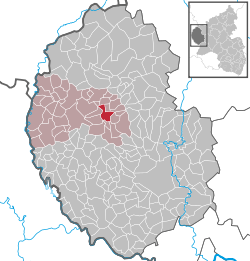Waxweiler
| Waxweiler | ||
|---|---|---|
| ||
 Waxweiler | ||
Location of Waxweiler within Eifelkreis Bitburg-Prüm district  | ||
| Coordinates: 50°5′30″N 6°21′52″E / 50.09167°N 6.36444°ECoordinates: 50°5′30″N 6°21′52″E / 50.09167°N 6.36444°E | ||
| Country | Germany | |
| State | Rhineland-Palatinate | |
| District | Eifelkreis Bitburg-Prüm | |
| Municipal assoc. | Arzfeld | |
| Government | ||
| • Mayor | Klaus Juchmes (CDU) | |
| Area | ||
| • Total | 5.96 km2 (2.30 sq mi) | |
| Elevation | 360 m (1,180 ft) | |
| Population (2012-12-31)[1] | ||
| • Total | 1,055 | |
| • Density | 180/km2 (460/sq mi) | |
| Time zone | CET/CEST (UTC+1/+2) | |
| Postal codes | 54649 | |
| Dialling codes | 06554 | |
| Vehicle registration | BIT | |
| Website | www.waxweiler.com | |
Waxweiler is a municipality in the county of Bitburg-Prüm, in Rhineland-Palatinate, western Germany. It is located in the Eifel, south of Prüm and is accessible through the Autobahn #60. The parish of about 1100 inhabitants lies 345 meters (1,132 feet) above sea level.
History
Roman artifacts dating to 150 AD on the hill "Am Hüttenberg" attest to the early origins of Waxweiler. In the Middle Ages Waxweiler was part of Austrasia in the Frankish Empire. Around 700 AD St. Willibrord (657 – 739 AD) a Benedictine Monk from Northumbria (Great Britain) brought Christianity to Waxweiler (see also Echternach Dancing Procession) and at that time the Church was founded in the town. The first official documents mention Waxweiler in 943 AD. From 962 AD Waxweiler belonged to the Holy Roman Empire until 1804 AD and the time of Napoleon. Prior to the opening of the Trier-Gerolstein railroad in 1871, four-span stage coaches traversed the routes Trier-Köln and Trier-Aachen. These passed through Waxweiler daily, one going and once coming. Shortly after the start of World War I, two German soldiers on guard duty were killed by friendly fire in Waxweiler. Until the end of WWI in 1919, a stage coach operated from Waxweiler to nearby villages. World War II started in 1939 and on January 8, 1945 a massive bomb attack occurred on Waxweiler. In 1945 and 1946, to make emergency repairs for extensive destruction by bombing and artillery, every able-bodied male inhabitant, age 16 to 60, was obligated to perform repairs or equivalent work without pay. Shortly before Christmas in 2004, a massive fire destroyed the bell tower of the church and caused extensive damage. The church and tower were rebuilt within two years.
References
- ↑ "Bevölkerung der Gemeinden am 31.12.2012". Statistisches Bundesamt (in German). 2013.
